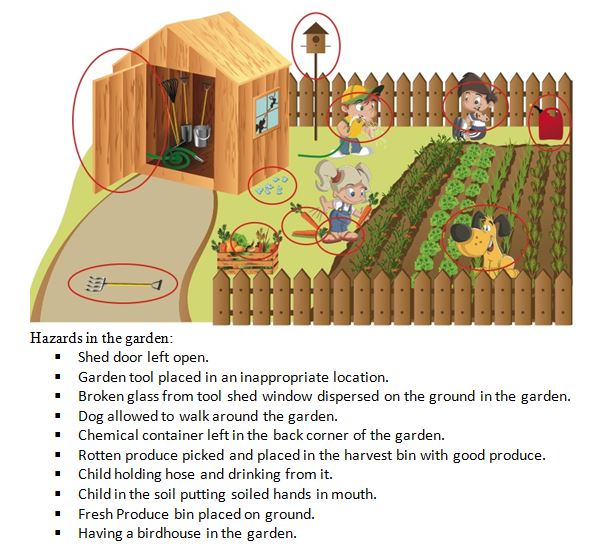 |
February 2016
|
February 2016 // Volume 54 // Number 1 // Tools of the Trade // v54-1tt7
Food Safety Education for Students and Workers in School Gardens and University Farms
Abstract
The number of school gardens and university farms is increasing in the United States. Produce grown in these venues is often sampled in the classroom or incorporated into the food chain. Food safety education for students and workers is needed to ensure that produce is safe. Two 1-hr food safety curricula were developed to inform K–12 students and university farm researchers and workers about good agricultural practices. The validated curricula include four or five short video modules, activities, instructor/facilitator lesson plans, knowledge assessment quizzes, and instructor manuals. Piloting results indicated that participants increased food safety knowledge after viewing these curricula.
School Gardens and University Farms and Food Safety
There is increased risk of illness from fresh produce due to its consumption in a raw state, with no intervention to kill harmful bacteria. Between the years 1998 and 2008, 46% of total reported food-borne illnesses in the United States were attributed to fresh produce and nuts; 22% of these were attributed to leafy vegetables (Painter et al., 2013).
It is estimated that there are close to 24 million students in kindergarten through grade 12 working in school gardens in the United States. Many of these school gardens are affiliated with farm-to-school programs used for teaching subjects such as nutrition, math, and science (U.S. Department of Agriculture Food and Nutrition Service, 2014). Produce grown in these gardens is often sent home with children or served in the classroom as samples. Farms located at universities are becoming increasingly popular as well. Although they are used primarily for teaching and research purposes, produce may be sold directly to markets or consumers.
School gardens and university farms may be overseen by teachers, volunteers, or employees who do not have training programs to educate their students/workers about the importance of safe food handling during growing and harvesting. Education is critical to ensure safe handling of the produce. Nayak, Tobin, Thomson, Radhakrishna, and LaBorde (2015) held an on-farm food safety workshop and evaluated learning outcomes through pre- and posttest assessments. They found an increase in knowledge, attitudes, confidence, and intentions to improve safe handling after the trainings. Although some states have developed online materials for school gardens and university farms intended for administrators of these units (Oregon Department of Education, 2013; Growing Gardeners, 2015), only a few have curricula specific for students and workers in the fields.
Use of Online Education
Educators have been using the Internet as a tool for teaching and learning for more than a decade (Barak & Dori, 2005). Online learning is expected to continue due to its many benefits, including reduced costs in travel and time, convenience, efficient training of individuals, shorter training programs, ease of availability, and ability to address a wide range of learning styles among participants (Bartley & Golek, 2004; Evans & Haase, 2001; Volery & Lord, 2000). Leary & Berge (2006) found that electronic learning helped bridge the gap of produce food safety learning; their survey results showed that knowledge increases after viewing online material. Mathiasen, Morley, Chapman, and Powell (2012) developed training videos to improve knowledge of agriculture workers about food safety in greenhouses and found these to be an effective resource.
New Online Food Safety Education Options
Food safety curricula for school gardens and university farms have been developed. The content of these curricula is based on current good agricultural practices (GAP), good handling practices (GHP), and good manufacturing practices (GMP) recommendations and includes information about practices from production through distribution of fresh produce. Each curricular module is approximately 1 hr in length.
School Garden Food Safety Curriculum
The school garden module is divided into four sections: introduction, preharvest best practices and prevention, postharvest best practices and prevention, and good handling practices and cross-contamination. None of the four sessions is longer than 10 min in length. Scripts were developed and aligned with a fifth-grade reading level. The following additional materials were developed for the curriculum:
- Case study activities (2)
- Hazard identification activity (1) (Figure 1 is an example of an activity for students in which they must circle and identify the hazards in the garden.)
- Separate activity specific to the content of each section (4)
- Instructor/facilitator plan for each section (4)
- Quiz with 10 multiple-choice knowledge questions for each section (4)
- Instructor resource guide with answer keys (1)
Figure 1.
Answer Key for School Garden Hazard Identification Activity

University Farm Curriculum
The university farm curriculum is divided into five sections, each no longer than 10 min: introduction and importance of training, preharvest best practices, postharvest best practices, good handling practices and proper personal hygiene, and current regulations in fresh produce. A module script was developed and aligned with a 12th-grade reading level. The following additional materials were developed for the curriculum:
- Case studies (2)
- Hazard identification activity (1)
- Crossword puzzle activity (1) (See Figure 2.)
- Quiz with 10 multiple-choice knowledge questions for each section (5)
- Instructor resource with answer keys (1)
Figure 2.
Example of University Farm Word Game

Validation of the Two Curricula
Modules were validated for content by a six-member expert steering committee consisting of specialists in the areas of food safety, horticulture, government education, and value-added agriculture. Two school garden and two university farm managers along with a convenience sample of three people from these populations evaluated the programs prior to release. Oral, written, and survey feedback was taken from the committee during development, and modifications and additions were incorporated into both modules. Surveys, using the Qualtrics System, addressed content, clarity, visual appeal, and format of the modules, with Likert scales and open-ended questions.
The curricula were piloted in two K–12 schools and at two university farms to assess knowledge change among students and farm workers. Results from the piloting showed increases in knowledge after viewing all four online sections of the school garden module. Farm workers at both universities showed increases in knowledge for all sections of the module except on the topic of personal hygiene/cross-contamination, in which no change was observed (Dzubak, Shaw, Strohbehn, & Naeve, 2015).
Summary
This project was successful in developing complete food safety training curricula for those working with elementary school gardens and university farms. The modules can be used by many groups involved with farm-to-school programs, community gardens, and colleges and universities. Completion of modules in schools and universities will help mitigate risks of food-borne illness and provide documentation that food safety information was communicated. Developed materials can be viewed at http://www.safeproduce.cals.iastate.edu.
Acknowledgment
Leopold Center for Sustainable Agriculture at Iowa State University provided funding for the development of these curricula. We would like to acknowledge Jodie Johnson, an undergraduate in Agricultural and Life Sciences Education, for her assistance in the development of the activities, teacher lesson plans, and artwork.
References
Barak, M., & Dori, Y. J. (2005). Enhancing undergraduate students' chemistry understanding through project-based learning in an IT environment. Science Education, 89, 117–139.
Bartley, S. J., & Golek, J. H. (2004). Evaluating the cost effectiveness of online and face-to face instruction. Educational Technology & Society, 7(4), 167–175.
Dzubak, J., Shaw, A., Strohbehn, C., & Naeve, L. (in review). Knowledge gained through an online food safety curriculum for school gardens and university farms.
Evans, J. R., & Haase, I. M. (2001). Online business in the twenty-first century: An analysis of potential target markets. Internet Research: Electronic Networking Applications Policy, 11(3), 246–260.
Growing Gardeners (2015). Garden Lessons. Retrieved from http://www.growinggardeners.net/garden-based-curriculum-1st-5th/
Leary, J., & Berge, Z. 2006. Trends and challenges of elearning in national and international agricultural development. International Journal of Education and Development Using ICT, 2(2), 51–59. Retreived from http://ijedict.dec.uwi.edu/viewarticle.php?id=179
Mathiasen, L., Morley, K., Chapman, B., & Powell, D. (2012). Using a training video to improve agriculture workers' knowledge of on-farm food safety. Journal of Extension [Online], 50(1) Article 1FEA6. Available at: http://www.joe.org/joe/2012february/a6.php
Nayak, R., Tobin, D., Thomson, J. Radhakrishna, R., & LaBorde, L. (2015). Evaluation of on-farm food safety programming in Pennsylvania: Implications for Extension. Journal of Extension [Online], 53(1) Article 1FEA9. Available at: http://www.joe.org/joe/2015february/a9.php
Oregon Department of Education (2013). School garden food safety training and documentation manual. Retrieved from http://www.ode.state.or.us/wma/nutrition/snp/entire_binder_10_31_2013.pdf
Painter, J. A., Hoekstra, R. M., Ayers, T., Tauxe, R. V., Braden, C. R., Angulo, F. J., & Griffin, P.M. (2013). Attribution of foodborne illnesses, hospitalizations, and deaths to food commodities by using outbreak data, United States, 1998–2008. Emerging Infectious Diseases, 19(3), 407–415.
U.S. Department of Agriculture Food and Nutrition Service (2014). Bringing the farm to school: The farm to school census. Retrieved from http://www.fns.usda.gov/farmtoschool/census#/
Volery, T., & Lord, D. (2000). Critical success factors in online education. International Journal of Educational Management, 14(5), 216–223.




